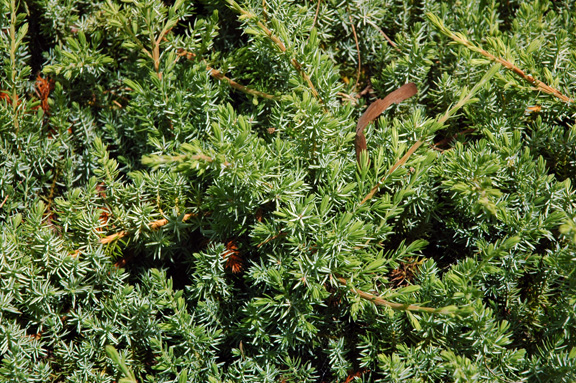
Woody > Juniperus > Juniperus taxifolia > Juniperus taxifolia
Juniperus taxifolia
Bonin Islands Juniper
Origin: Japan. The Bonin Island Juniper grows in the small Bonin Islands on the coast of Japan. Also common in the Ryukyu Islands (intertwined with The Bonin Islands).
Mike's
Opinion


"
Juniperus taxifolia is a coniferous evergreen shrub that grows 1-3 m tall and in rare cases can grow up to 13 m. It has brown exfoliating bark and green AWL like Foliage that can sometimes become a blueish colour depending on seed,genetic variation and environment. J. taxifolia is hardy and tolerates cold climates. It prefers moist soils and full sun. Commonly used as windbreak but has often been used in the art of bonsai or as a specimen plant because of their short stature ness and ability to be manipulated. Native to The Bonin Islands which was colonized in 1830, and is located 1000 km off the coast of Japan. Juniperus taxifolia is a great for ground cover.
Michael Pascoe, NDP., ODH., CLT., MSc. (Plant Conservation)
"
| Family |
| Cuppresaceae |
| Genus |
| Juniperus |
| Species |
| taxifolia |
| Category |
| Woody |
| Type |
| Shrub (evergreen) |
| Pronunciation |
| USDA Hardiness Zone |
| 5b |
| Canadian Hardiness Zone |
| 5a |
| RHS Hardiness Zone |
| H6 |
| Temperature (°C) |
| -30-40 |
| Temperature (°F) |
| 90-10 |
| Height |
| 1-3 m |
| Spread |
| 3 m |
Photographs
Description and Growing Information
Flowering Period
| General Description |
| Juniperus taxifolia is a slow growing coniferous evergreen shrub with bluish foliage. It is native to Bonin Islands in Japan. |
| Landscape |
| Juniperus taxifolia is often planted as a windbreak or used as an ornament Plant. it can be trained into a bonsai tree. It can be used in rock gardens or as a ground cover. However, If it grows big enough it is sometimes used as a specimen plant. |
| Cultivation |
| J. taxifolia requires moist well draining soils and can tolerate acidic soils. J. taxifolia prefers moist, well drained, alkaline soils. Grows best in full sun but will still grow in partial sun conditions. Grows best in a PH range of 5 to 7. |
| Shape |
| Juniperus taxifolia has a low lying mound like shape and grows 1-3 m. Has a cloudy ball like shape from distance. |
| Growth |
| Medium |
| ID Characteristic |
| J. taxifolia has awl foliage that is bluish-green. It is Small in height and requires shallow well drained soils. Fruit is cone like with small round fruit like seeds. It produces a cone that is small and round to protect fruit. |
| Pests |
| J. taxifolia is vulnerable to common juniper pests and diseases such as Twig blight, Cedar apple rust. Cedar rust effects the foliage while twig blight prevents limbs from getting nutrients. |
| Habitat |
| Ryukyu Islands and the adjacent coastline of Shizuoka Prefecture. J. taxifolia is native to The Bonin Islands. Prefers moist soils and thrives on coast lines. Tolerates acidic soils but grows best in neutral soils. |
| Bark/Stem Description |
| The mature bark on the trunk is exfoliating and light brown, branches on new growth are dull brown, smooth with no exfoliating bark. |
| Flower/Leaf Bud Description |
| J. taxifolia Buds are green and turn a reddish brown colour with a white waxy coating as they mature.They grow in groups of 3, hanging from the end of branches. Often have single point, roughly 10 mm in diameter. |
| Leaf Description |
| Foliage is Awl and come in fascicles of 3 needles are a light green colour. 7 to 14 mm in length and roughly 2 mm wide. Foliage is rigid, waxy and slick. |
| Flower Description |
| Flowering process takes up to 18 months to complete. Flowers February to March. Requires male and female plants to propagate.Flowers are ball like seed coatings that ripen. |
| Fruit Description |
| J. taxifolia fruit starts off green turning reddish brown with white waxy coating with age.Grow in groups of 3. Often have single point, roughly 10 mm in diameter. Becomes scale like to protect seed. |
| Colour Description |
| Foliage is green during summer months and turns a bluish colour in the winter depending on seed variation and environment. Mature bark is a darker than new growth. Ripe fruit is reddish Brown. New seed pods are light green. |
| Texture Description |
| Juniperus taxifolia bark has a coarse texture with fine hairs resulting from exfoliating bark. Foliage is rigid, waxy and slick. |
| Notable Specimens |
| Notable specimens regarding Juniperus taxifolia can be found scattered all over the Bonin Islands. They grow up to 13 m in the wild. |
| Propagation |
| J. taxifolia is propagated (in nature) by birds feeding on the fruit when stopping for rest on the islands and transporting its seeds through its feces. Often likes to be planted in groups so it can bind together. Does best in well drained soils and commonly propagated as a windbreak. People often propagate by seed but can also be grafted to other junipers. |
| Ethnobotanical Uses (Disclaimer) |
| Juniperus taxifolia has no known ethnobotanical uses. |

